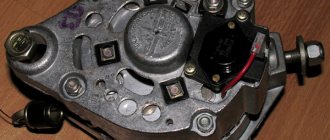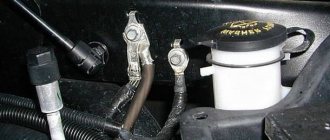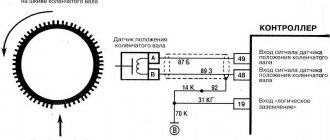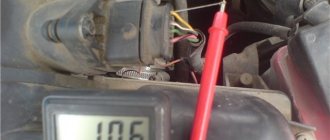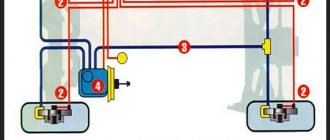How to check the battery
When learning how to measure battery capacity with a multimeter, you need to consider the procedure for a vehicle battery.
A full check of the autonomous power source will allow you to avoid problems in the vehicle’s electrical network and extend the life of the battery. First, the battery must be disconnected from the machine system. It is allowed to disconnect only the “minus” contact. Next you need to turn on the multimeter. The test mode is set to the range from 0 to 20 V.
The multimeter probes are connected to the battery contacts. A red wire is connected to the positive terminal, and a black wire is connected to the negative terminal. If this procedure is performed correctly, the measurement result will appear on the device screen.
Measurements while the engine is running
Place the car on a level surface, open the hood, put the handbrake on and start it. When the engine is running, the generator and voltage regulator operate, which charge the battery. Therefore, the voltage at the terminals should be within 13.5-14 volts. In some cars, when the battery is discharged and the air temperature is low, the electronics automatically increases the voltage to speed up charging. In this case, it should fall smoothly as it charges. If this does not happen, the electrolysis process is activated in the banks. The electrolyte will begin to boil away rapidly. Overcharging is especially dangerous for modern gel batteries with limited gas emissions.
A voltage of less than 13.4 volts is a sign of undercharging. Operating in such conditions promotes sulfation of the plates and shortens battery life.
When measuring voltage, you need to turn off all powerful consumers: headlights, heater, audio system. Otherwise, the power of the generator when idling will not be enough to maintain the optimal voltage level.
There are several possible reasons for low voltage at the terminals:
- Poor contact.
- Generator failure.
- Voltage regulator malfunction.
You cannot operate a machine whose battery is in undercharge mode. The cause of the failure must be immediately localized and eliminated. If the voltage at the terminals and the output of the generator is very different, you need to clean the contacts on the battery with sandpaper or a file.
After checking without load, you need to turn on the headlights and other powerful energy consumers, add engine speed and repeat the measurements. If at high speeds under load the voltage drops to 13.4 volts or lower, diagnostics of the generator system and control unit is required.
How to test a battery with a multimeter with the engine turned off?
The average indicator, when checking the battery with a multimeter, with the engine not running, should be in the range of 12.5–13 V, with the upper value indicating 100% charge, and the lower value indicating 50%. The numbers are approximate, but the general picture is easy to understand. Also, do not forget that you should take readings immediately before the trip, and not after it, as soon as you have turned off the engine. It is especially good to carry it out when the car has not been used for some time, for example, in the morning after a night in the garage. This shows how well the battery can hold a charge.
Now you understand how to check the charge of a car battery with a multimeter. This device is worth purchasing for every motorist. Some rely on the on-board computer, but it does not provide sufficient accuracy. The built-in voltmeter is connected to the circuit of devices that consume energy, and not directly to the battery, therefore, part of the electricity is consumed “on the road”.
What parameters can you use to check a battery with a multimeter?
Using a multimeter, you can check the following characteristic parameters of the battery:
- Its nominal or operating voltage (it indicates the quality of charging).
- The strength of the current supplied to the load in normal mode.
- Energy intensity.
Please note: The last characteristic is defined as the ability to supply a current of a certain amount to a load for a given period of time.
The nominal voltage measured at the terminals of the device determines how well the battery is charged.
How to check battery charge
Before you check the charge of a car battery with a multimeter, you need to know that using this device it is impossible to check the state of charge of the battery. The assessment can be made using a load fork, which allows the charge to be assessed with a high degree of accuracy.
Checking the state of charge of the battery involves briefly connecting the load plug with obligatory observance of the polarity of the connection.
Important! The time of such connection should not exceed 5 seconds.
Before and after switching the load, you need to measure the voltage at the battery terminals. Before connecting it, it should be within 12.6-13.0 Volts, and after completing the load operation (after the fifth second) - at least 10.5 Volts. Only in this case is the battery being tested considered to be well charged, that is, capable of operating under load for a long time.
If during the test the voltage at the terminals drops below 9 Volts, the battery is considered non-working and needs to be restored. In this situation, it is recommended to worry about purchasing a new battery model.
You can see how to check and adjust the battery charging current using a multimeter in the video below.
How to check a battery for leakage current
Any energy-storing device capable of “supplying” current to an external load may leak. When operating such devices, it is important to ensure that the value of these currents does not exceed a certain level. For car batteries, in particular, it should not be more than 50 mA.
The presence of leaks is explained by the fact that energy in small quantities is spent to provide current to “parasitic” circuits that are not intended for operating purposes. In addition, they may appear due to the need to expend energy to maintain the functioning of a security alarm, for example.
If “non-operating” leaks exceed the limit level, it will be necessary to carry out diagnostics of the system, accompanied by measuring the value of “stray” currents. To do this, you must perform the following operations in the sequence indicated below:
- Turn off the engine of a running car by turning off the ignition.
- Wait until it cools completely (about 10-15 minutes).
- Turn off all energy consumers without exception.
- Remove the contact from the negative terminal of the battery.
- Set the multimeter's measurement mode dial to DC current, and then select a range of up to 10 Amps.
- Connect the red wire of the device to the negative of the battery, and connect a probe in black insulation to the removed terminal.
Based on the readings of the tester included in this circuit, one can judge the presence or absence of “stray” currents. In the same way, their absolute value is determined.
Methods for detecting leaks
It is very simple to check which specific part of the automotive network is leaking. To do this, you need to disconnect and then reconnect the fuses on the distribution panel one by one. If, when removing the next protective element, it disappears (the multimeter shows “0”), this means that it is in this circuit that “parasitic” currents appear.
Many users are also interested in the question of whether it is possible to find a leak on the battery without a device. In order to solve this problem, you will need to do the following:
- Turn off all light sources and close the door.
- Stop the engine and open the hood.
- The security alarm must be completely disconnected from the on-board network.
After this, you need to remove the supply cable from the positive terminal and wait for 5 minutes. Then you should reconnect the battery terminal and observe the type of spark that is formed. A sufficiently powerful discharge indicates that a leak is present. A small spark indicates the natural processes that occur when an electrical circuit is broken and restored (there is no leakage).
Dirty battery leakage current
Under certain conditions, leakage by parasitic currents can occur due to severe contamination of the working surface of the battery in the area of the contact terminals. Dirt often accumulates in these places due to poor battery care, which requires constant keeping clean.
Dirt deposits from oil, electrolyte fumes and dust that accumulate over time form a thin film, which is a good conductor of current. It is because of this that strong leaks are discovered over time, leading to rapid battery discharge. This unpleasant phenomenon can be eliminated very simply. To do this, it is enough to constantly keep your battery clean by regularly wiping its surfaces with a rag or pieces of soft flannel cloth.
We measure the density of the electrolyte
There is only one method to check the density of the battery electrolyte using a multimeter. It comes down to measuring the nominal DC voltage without load. This approach to density assessment allows you to quickly determine whether a battery is faulty.
How to Visually Check a Car Battery Case and Cables
Now it's time to check the physical condition of your battery. A damaged battery case can not only prevent the battery from working properly, but can ultimately kill it. To check it, you need to remove it from your car.
Disconnect the cables first, starting with the ground terminal and then the positive terminal. Now unscrew the clamping mechanism to remove the battery from the tray. Make sure the holding mechanism works. If it doesn't exist, install it. This equipment prevents the battery from rebounding and becoming damaged while the vehicle is in motion.
Place it on a work surface or similar surface. Carefully inspect the battery case for possible damage. Check for a bulging side or cover, cracks around the housing, or damaged terminals. If your battery is damaged, replace it. Overcharging and internal short circuit will cause the battery to swell as the acid turns to gas. So if you notice signs of a bulge, check the charging system as well.
Now check the cables. Check the insulation around the cables and the condition of the cable threads for wear, cracks or fraying. Replace them if necessary. Make sure the clamp mechanism on your battery is working.
What parameters can be checked?
Using a multimeter, you can measure voltage with high accuracy. By the magnitude of the electrical voltage, you can determine whether the battery is charged or the element needs to be charged with direct current.
Using a multimeter, you can check the voltage not only of acid batteries, but also of cell phone batteries. To check the mobile phone's battery charge level, the device is switched to the mode for measuring direct current up to 20 V. In this mode, the digital device allows you to measure voltage with an accuracy of hundredths of a volt.
The screwdriver battery can also be easily checked with a multimeter. The rated voltage of the device, in this case, can be found out from the documentation of the power tool, and if the voltage is less than this value, then the battery must be charged.
The battery capacity can also be checked with a multimeter. For this purpose, you can use several methods.
You can check current leakage using a multimeter. If it is necessary to measure this parameter on a car, then in addition to the current leakage on the body, the leakage in the vehicle’s on-board network is also checked.
In this way, you can prevent rapid discharge of the battery and increase its service life.
How to check battery charge with a multimeter?
Determining the condition of a lithium-ion (the most common type of modern battery) battery is quite simple if you follow these instructions:
- Disconnect the energy storage device from the car and wait 5-6 hours.
- The multimeter should operate in the “voltage” mode (voltage test).
- A standard lithium battery produces current in the range of 12.7–13.2 volts. The switch is set to 20 or closest to it. This is how the voltage is measured from this value and below.
- The wires coming from the device are connected to the battery: red to the positive terminal, black to the negative terminal. If the wires are the same color, then you should focus on their markings and connect them to opposite charges, minus to plus and vice versa.
What can you check with a multimeter?
This measuring device will be useful to every car owner. With it, you can quickly, “in the field,” determine a number of indicators. And by the numbers they can judge whether the battery is working properly or whether there is something wrong with it.
Charge
The most modern car batteries are lithium-ion (Li-Ion). Using a multimeter it is easy to check whether the battery is charged or not. This is done like this:
- Disconnect the battery and allow it to “rest” for 5–6 hours.
- The multimeter is switched to the “Voltage” mode (voltage measurement).
- Lithium batteries produce a current in the range of 12.7 - 13.2 V, so the device is set to 20 V. The voltage from this value and below will be measured.
- The multimeter wires are connected to the battery: red – to “plus”, black – to “minus”. If the cables are the same color, follow the markings.
The multimeter should show numbers on the display. They are used to judge the condition of the battery:
- 12.7 – 13.2 V – the power supply is working;
- 12.1 – 12.4 V – approximately half charge, that is, you need to replenish the supply;
- 11.6 – 12 V – a “depleted” battery, which is unlikely to serve as a source of energy;
- up to 11 V – a used battery that can be sent for recycling.
Table for determining the degree of charge of the battery by voltage.
It’s not difficult to check the battery with a multimeter to assess its performance offhand; it just takes a little time.
Leakage current
Current leakage is an indicator that reflects how much energy is spent to maintain the operation of consumers connected to the on-board network. Each battery has a specific minimum current leakage value. On average it is from 55 to 80 mA.
These are the currents that “go” to maintain the functioning of the radio, fuel injection system, alarm system, etc. The total leakage should not exceed 70 mA. If it is more, the battery will begin to discharge more strongly, which will quickly shorten its service life.
Current leakage test:
Checking leakage current with a multimeter.
- All energy consumers are turned off.
- Remove the negative terminal from the battery.
- The multimeter is switched to DC current measurement mode in the range of up to 10 A.
- The “positive” wire of the device is connected to the “plus” of the battery.
- The minus of the tester is connected to the removed “minus”.
- Read the readings.
If there are no leaks, it will show zeros. If there is a leak, it will be clear how quickly the battery drains. If the values are higher than normal, it is necessary to determine the voracious consumer by turning off the fuses one by one and returning them to their place.
Density
Typically, the electrolyte level is checked with a special glass tube that has a graduated scale - a hydrometer. But a multimeter will do. Instructions:
- The tester is switched to the “Voltage” mode, wires with “crocodiles” are connected to it.
- The switch is set to 20 V - it will show everything below.
- The black wire is connected to the “minus”, the red wire to the “plus”.
- They look at the voltage value and compare it with the norm. A fully charged battery has 12.7 V. If 12.1 - 12.4 is half charged, the density is not normal.
It is recommended to measure the electrolyte density every 15 - 20 thousand kilometers.
Electrolyte density at different temperatures.
Capacity
Capacity can be measured by test discharge of the battery. First, fully charge the battery. To make sure that it is fully charged, check the voltage and density of the electrolyte.
Then a load is connected, for example, a 24 V light bulb, and the time is recorded. When the voltage drops to 50%, the incandescent lamp is turned off. Energy intensity, measured in Ampere-hours (Ah), is measured as follows: multiply the current in the circuit with a connected load by the number of hours allocated to the control discharge. If the resulting value is close to the nominal value, then everything is fine with the batteries.
Voltage
Normal battery voltage.
The check can be performed with the engine turned off. The norm is 13.5 – 14 V. A battery with this voltage is considered to be in good condition.
If the device displays more than 14.2 V, the battery is not fully charged. At this time, the generator works hard to provide energy to all consumers. In winter, the battery freezes and discharges, so the test may not show the correct values the first time.
If you check with the engine running and consumers disconnected, and the device shows less than 13 V, then the generator is operating intermittently, that is, it is not able to fully charge the battery.
Internal resistance
The measurements are simple, but you will need a load, for example, a 60 W halogen light bulb with a current consumption of 5 A. With an amperage of 100 A, the voltage loss should not exceed 1 V. Accordingly, at 5 A - about 0.05 V. Instructions:
- Connect the lamp to the battery and wait for it to light up.
- Check the voltage with a multimeter and record the value.
- Turn off the lamp and check the new voltage readings.
If the difference is no more than 0.05 V, the battery is working. Large values indicate wear.
A multimeter is an easy-to-learn device that every driver should own. With it, you can quickly assess the condition of the power source and take timely actions to extend its service life. At the same time, many rely on the information from the on-board computer, but it is not so accurate.
Using a hydrometer to check battery fluid
- Remove the caps from the top of the battery.
- Immerse the tip of the hydrometer into the first cell of the battery and squeeze out the hydrometer bulb.
- Release the bulb so that the electrolyte enters the hydrometer needle.
- Read the specific gravity of the electrolyte as indicated in the instructions on the tool packaging.
- Record your values and perform the same test on the remaining cells.
- Compare your results with the results of the tool manufacturer's instructions.
Basically, if your readings fall between 1.265 and 1.299, your battery is charged. When your readings drop below 1.265, your battery will not be sufficiently charged. In most cases, a slow or fast charge will help restore charge and improve the chemistry in the battery. However, a difference between 25 and 50 points or more (the point is 0.001) between any of your readings indicates that the battery is sulfated and you need to replace it.
What to pay attention to
When checking the battery charge, it is also important to measure its operating level. To do this, you will need a load fork - a measuring device that will help you correctly measure the battery charge and check its condition.
The fact is that the multimeter itself shows voltage without load, i.e. when the car is at rest. When checking the charge with a load plug, the battery voltage drops to 9 V, then gradually recovers. If the voltage drops below 9 V, for example to 6 V, then the battery capacity is too low.
In conclusion, I would like to say that using a multimeter does not require much knowledge. It is enough to be able to read and distinguish colors (and anyone can do this). Therefore, if you are a car owner and have not yet purchased such a measuring device, then think about buying it. After all, it’s better to spend a little money once than to constantly experience stress when the battery suddenly discharges again.
Add ProCrossovers to your favorites
How to check the battery charge using the indicator
Many maintenance-free batteries have charge indicators that allow you to visually determine the condition of the battery. This option first appeared on Japanese products and quickly gained popularity due to its convenience and accessibility.
The hydrometer, as the indicator is called, is a transparent window on the battery cover. The color of the window changes depending on the condition of the battery:
- Green —full charge.
- Gray or white - need to be charged.
For some indicators, the window turns red when capacity is lost.
The principle of operation of the device is based on changes in the density of the electrolyte at different charge levels. It works like this:
A tube with a green float is attached to the window.
- When charging the battery, the density of the electrolyte increases and the float rises, approaching the window.
- If the battery is discharged, the density drops and the ball sinks in the electrolyte. As a result, the indicator window changes color to gray or black.
Some indicator models have a red ball that floats up when the density of the electrolyte decreases. This provides a red indication of the discharge.
When the electrolyte level drops, not the ball, but the electrolyte itself will be visible through the window. To prevent the destruction of the plates, you need to add distilled water to the jars and charge the battery.
The advantage of the indicator is that the device allows you to determine the condition of the battery without the use of special instruments. This is convenient when purchasing a battery or in road conditions when you need to quickly check the condition of the battery. However, indication using a float does not always allow one to draw accurate conclusions about the performance of the battery. Therefore, when in doubt, you should use a multimeter or a load fork. They are also useful when you need to check a battery that is not equipped with an indicator.
Why use a multimeter to check the battery?
A multimeter is an indispensable thing if you are a car owner. After all, situations are different, you may urgently need to measure the battery charge, and the nearest service station is tens of kilometers away. And why spend money on measuring the charge at a service station every time, if you can buy a multimeter once and forget about the problems.
For example, the following situation arose. Your car has been sitting in the garage for a long time with the battery terminal disconnected, and suddenly there is a need to go somewhere and it is unclear what and how the battery is charged, even if the engine starts without problems. In such a situation, you just need to take a multimeter and measure the battery voltage with it. If this is not done, then a low charge level on the road can be a fatal mistake. The density of the electrolyte will drop due to “undercharging”, and in cold weather the battery will simply freeze, or its slow destruction will occur.
At the same time, it is not necessary to buy an expensive device; even the most budget option will cope with the task.
How to Test Battery Terminals Using a Multimeter
Dirty, corroded or loose terminals will lead to starting or no-starting problems and are one of the main reasons people think they have a "dead battery". Sometimes such problems are difficult to detect with a simple visual inspection.
Here you will use a voltmeter (or multimeter set to voltage) to check the battery terminals for voltage drop so you can understand the status of your battery connections.
First turn off the ignition system. Do this by temporarily disconnecting the ignition coil or removing the fuse, or the fuel pump relay (if necessary, find your vehicle's owner's manual or your vehicle's repair manual to locate the coil or fuse). This will prevent your engine from starting.
Use the red positive wire to touch the positive terminal of the battery and hold. Touch the black wire (negative) of your meter to the terminal of the negative wire that goes onto the battery. Have a helper crank the engine. If your meter registers more than 0.5 volts, you will need to clean or check the physical condition of the terminal and terminals.
Now check the other battery terminal. This time, however, use the black probe of your meter to touch the negative terminal of the battery. Now touch the red probe of your meter to the cable terminal connecting to the same battery terminal. Have your helper start the engine and check the voltage reading on your meter. If it exceeds 0.5 volts, you need to check the battery terminal for damage or clean it.
Which batteries can be tested with a multimeter?
All types of batteries are characterized by parameters such as capacity, current or voltage, so using a measuring device you can easily check any battery for performance.
Most often, due to its widespread use, it is necessary to measure the performance of car batteries, Ni-Cd, Ni-MH, Li-Pol and Li-Ion batteries in this way.
Even if a car or gadget is equipped with standard programs for measuring battery charge, in many cases, such utilities show general information about the amount of charge. At the same time, the accuracy of such utilities cannot always be trusted.
How to check the “amperage” of a battery with a multimeter?
To determine the current that your battery produces, you will need to create a circuit with a load. Its role is played by any device or equipment that consumes electricity. To take measurements you will need to take the following steps:
- The device is set to ampere measurement mode, and the switch on it is set to alternating current, which is designated by the English letters AC.
- Disconnect the positive terminal of the battery and replace it with the negative wire of the measuring device.
- To the equipment that acts as a load, connect the negative terminal of the battery and the meter probe with a positive charge.
- Depending on the design, look at the displayed number or count it on the instrument scale.
A serviceable and fully charged battery exhibits readings in the range of 12.6–13 V.
How to check battery charge with a multimeter?
Most modern batteries have a special sensor that changes its color depending on the battery charge. However, it will not be possible to obtain accurate data using it.
How to check battery voltage with a multimeter?
To check the charge of a lithium-ion battery, you must perform the following steps:
- Switch the multimeter to voltmeter mode (voltage measurement) and set the range from 0 to 20V;
- Disconnect the battery from the car's electrical wiring;
- Connect the red probe to the positive socket;
- Connect the black probe to the negative socket;
- Record your readings.
If the multimeter shows that the voltage is 12.6 volts, then this indicates that the battery does not need to be charged and is fully functional. If the readings are below 12.6, this indicates the need to recharge the battery.
If the multimeter shows less than twelve volts, then the battery is completely discharged and needs to be charged urgently. If the reading is less than eleven volts, using such a battery can burn out the generator or charger, which means it is better to get rid of it and buy a new one.
It is important to remember that to obtain current data you need to check the charge, you need to wait 5-6 hours after the battery is disconnected from the car.
How to check battery charging from a generator with a multimeter? In exactly the same way, but now to measure the indicators, you will need to disconnect the generator from the battery, obtain the necessary data, and, if necessary, put it back on charge.
How to test a battery with a load fork?
This is the most accurate method to determine the state of charge and the ability of the battery to operate at full load. It is used by professional auto electricians in service centers.
A load fork is a device that combines a voltmeter and a load resistance. Advanced versions of the device are also equipped with an ammeter, which allows you to estimate the load current. The fork operates in two modes:
- battery voltage measurement;
- imitation of starter operation.
Before starting the test, you should turn on the voltmeter mode on the load plug and connect it to the battery. If the device shows less than 12.7 volts, the battery needs to be charged.
| Voltmeter readings under load | >10.2 V | 9.6 V | 9.0 V | 8.4 V | <7.8 V |
| Charge percentage | 100% | 75% | 50% | 25% | 0% |
How to check battery capacity with a multimeter?
Another important indicator is the battery capacity. This characteristic shows how much charge it will give over a specific period of time, at a certain voltage, and it is measured in ampere-hours.
The capacity of a car battery can be checked in several ways using a multimeter.
Checking the car battery capacity under load
One way to check the battery capacity using a multimeter is to use a load, which can be a regular light bulb. It is worth remembering that if it begins to gradually fade, then you can end the test, since the battery is inoperative.
The load for testing the battery must be selected in such a way that it can take half the battery current, that is, if the capacity is 7 Amperes per hour, then the load should be 3.5 Volts. An excellent option could be a car headlight with a power of 35-40 watts.
This procedure looks like this step by step:
- The battery is disconnected from the generator;
- The load is connected;
- The battery should run under load for about two minutes;
- The load is turned off;
- A multimeter is connected to the battery in voltage measurement mode;
- Indicators are taken.
If the battery is working properly, then its voltage should be above 12.4 Volts. Accordingly, any problems during startup are most likely caused by a malfunction of the electrical wiring or other vehicle systems. If the multimeter readings are in the range from 12 to 12.4 Volts, this means that it will not work for a long time and you will soon need to purchase a new battery.
Reinstalling the battery
After cleaning the case, terminals and tray, reinstall the battery.
- Carefully place it on the tray.
- Attach to tray using clamping mechanism.
- Connect the terminals. This time, start with the positive terminal and connect the negative or ground terminal last.
- After connecting the terminals, spread a thin layer of Vaseline around the top of the terminals and terminal posts. This prevents corrosion from accumulating around the terminals.
Quick battery check
In some cases, car owners have absolutely no time to disconnect the battery from the car, as well as “digging” with the lighting and dashboard. Such car owners determine the battery charge level without removing it, right under the hood.
The process looks like this:
- When the car freezes after turning off the engine, the multimeter is connected to the battery according to the scheme: plus to “+”, minus to “minus”, respectively. It is worth considering that the indicators will have minor deviations. 12.7 Volts is a normal indicator.
- Then the car starts. When the motor starts, the voltage will rise to 14.7 Volts.
- It is recommended to check it under load (external lighting, window heating, medium heater mode). In this case, the norm is 14.6 Volts.
Measuring the voltage of a car battery with a multimeter is a feasible task even for a novice car enthusiast. Not everyone can afford an expensive battery equipped with a special indicator.
A practical and universal option is to measure the battery charge with a multimeter. This device, with a talking prefix “MULTI”, allows you to measure not only voltage, but also current. In addition, the multimeter can be useful for other electrical equipment, including phones, laptops, and screwdrivers. Remember that it is better to purchase such a device from trusted manufacturers in specialized stores.
How to clean a car battery
- Cleaning the battery case
You can use a simple procedure to clean the battery case. To do this, you need to prepare a mixture of 8 ounces of warm water and one tablespoon of baking soda. This neutralizes the acid and helps remove dirt from the battery case and terminals.
Wear safety glasses and rubber gloves and, using a soft brush, apply the solution to the top of the battery and the sides of the case. If your battery uses compartment caps (serviceable batteries), do not allow the mixture to seep under the caps and mix with the electrolyte inside.
Wipe with the solution and a clean rag. Continue applying the cleaning solution until you see no signs of buildup.
- Cleaning the Battery Terminals
As with the battery, remove dirt and corrosion from the terminals using baking soda and a water solution.
To make your task easier, pour the mixture into a Styrofoam or similar disposable cup and submerge the battery terminal in it for a minute or two. Next, use a battery compartment cleaning tool to finish removing corrosion from the terminals. Repeat the procedure until you see that both cables are free of corrosion.
- Cleaning the battery compartment
Check the condition of the battery compartment. Make sure there are no screws, cracks, pieces of dirt or signs of corrosion. If necessary, use the same solution to remove dirt and corrosion from the pan.
How to make a device with your own hands
When the necessary equipment is not available, you can make the device yourself by watching the video. It is necessary to take a voltmeter from ready-made instruments, and the remaining parts are constructed from improvised means. Difficulties will arise when calculating and creating internal resistance, which requires current.
A suitable material is nichrome wire, used to create heating coils in electric stoves. Nichrome elements can be replaced with a metal strip from other heating devices.
For a voltage of 12 V, the current indicator should be within 80-120 Amperes, and the resistance should be 0.1-0.15 Ohms. A device for measuring such resistance is difficult to find. For this reason, the length of one element is selected and the current that it passes is measured. After this, several similar parts are combined.
A homemade device is made sequentially:
- Select a nichrome wire or heating strip and measure the current up to 15 A with a multimeter. The element should pass 10-12 A.
- 10 such parts are connected, receiving a load of 100-120 A. The wire must be twisted securely.
- The resulting element is placed in a suitable housing and fixed in it. If the box is small, then the wire is bent several times so that the turns do not touch each other. The parallel connection must be reliable, which is ensured by insulating cylinders that are installed on the bends.
- The ends of the twist are soldered to the output contacts, and from the outside to the connecting wires.
- Connect a voltmeter.
- Clamps are attached to the ends of the connecting cable, which are then connected to the battery.
When the device is ready, you can take measurements at home.



